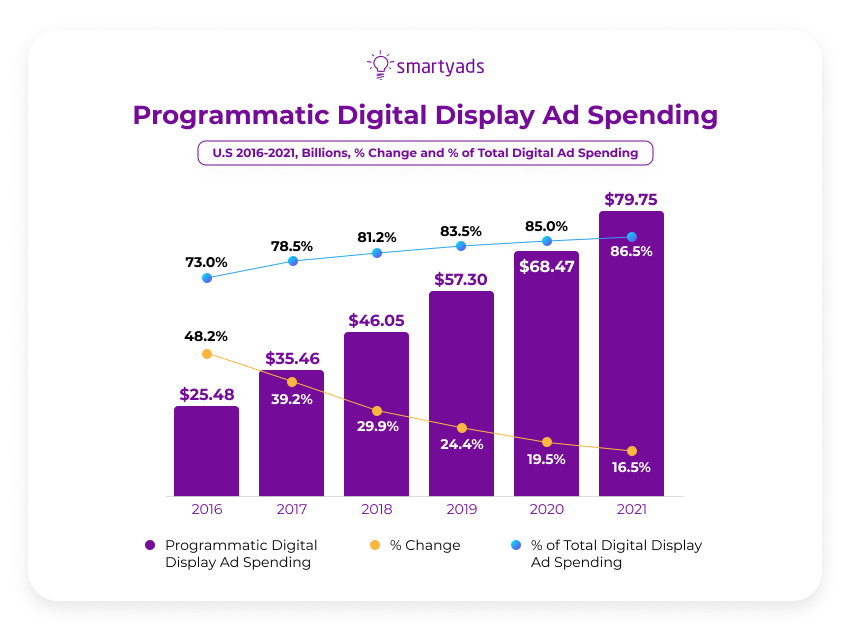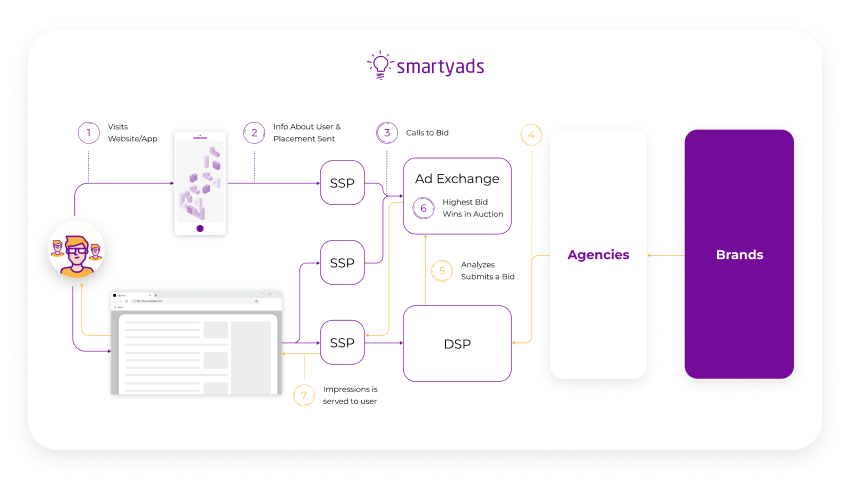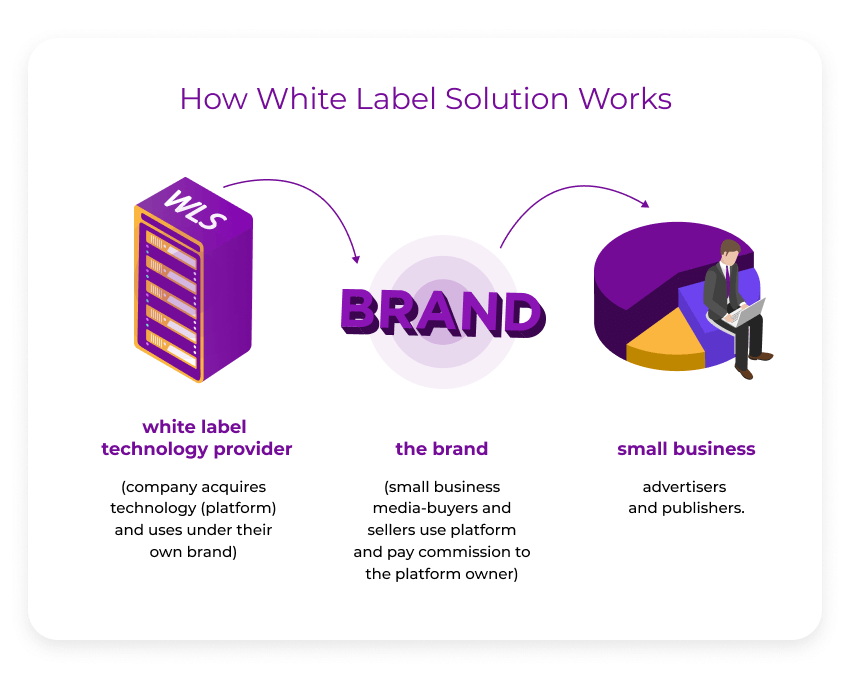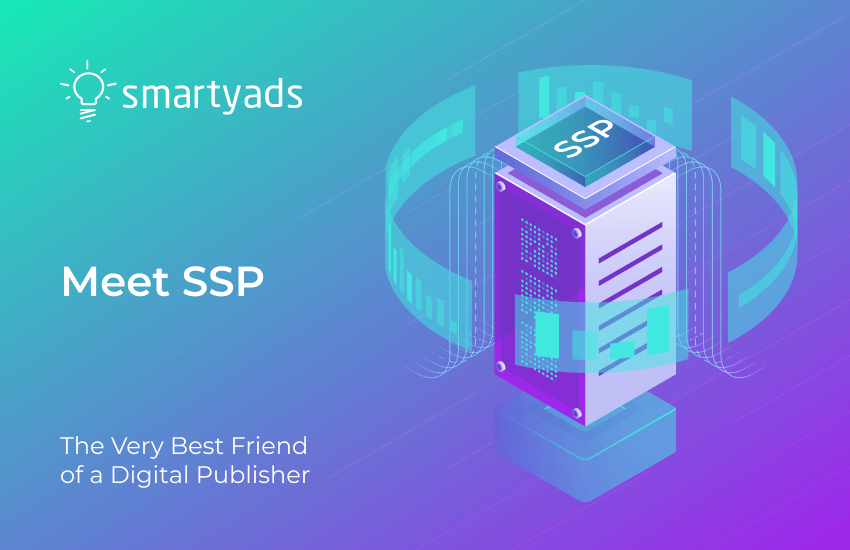In the era of online advertising, publishers don't sell advertising space as they did several decades ago. Modern digital advertising sells impressions to highly-targeted audience segments. The programmatic media buying process involves demand-side platforms (DSPs), as well as ad exchanges, ad networks, and supply side platforms SSPs. These ad tech entities are interlinked and work in a single programmatic media buying ecosystem. It matches demand with supply based on targeting options, budget settings, and other parameters important for buyers and sellers.
This ecosystem integrates a multitude of demand sources and supply partners each of which broadens media-trading opportunities. If publishers want to sell their ad space effectively, they should learn how to use a technological platform for sellers SSP. Exactly SSP is aimed to make media-selling efficient and suit it to every publisher.
What is SSP?
Supply side platform SSP is an advertising software that publishers use to sell online advertising space, optimize it, and analyze the results. Supply side platform has a dashboard with in-built publisher’s controls. They help to manage ad inventory (position, ad format, size, etc.), the price per impression, and other campaign details. As well, they allow publishers to extract the maximum value from every piece of available inventory as it is getting auctioned between advertisers in real-time.
What is the difference between SSP and DSP?
There’s no such battle as SSP vs DSP. Sure the acronyms are very similar but these two perform completely different functions. Shortly, SSP is an equivalent of the demand-side platform for advertisers but SSP is created for publishers. Using supply side technology like SSP, publishers can sell ad space to various demand side platforms and simultaneously offer it to a connected ad exchange, ad network, and all kinds of other RTB platforms. They automate ad inventory filling, match publisher's requirements with demand, perform ad selection, and yield optimization. Just like advertisers configure ad campaigns in DSP dashboards, publishers configure the ad serving process in the dashboard of SSPs.
Why do you need SSP as a publisher?
Both publishers and advertisers are turning less to traditional media-trading. The media buying process has become fully automated, which saves time and reduces the internet advertising budget. Thus, we can see that advertisers have massively shifted to programmatic advertising together with publishers.

Before the advent of programmatic, website owners couldn't control the starting price of an impression. Thus the media cost was essentially determined by the advertisers. When SSPs came to the scene, this problem disappeared. Through RTB it connects publishers to the worldwide pool of advertisers maximining the competition and removing the problem with inadequate pricing. As well SSPs give publishers the opportunity to diversify pricing for their inventory to keep it profitable yet flexible enough to score more deals.
Advantages publishers get while using SSPs
1) Higher yields. The chance to reach as many advertisers as possible across the programmatic ecosystem - DSPs, exchanges, networks. A larger circle of potential buyers elevates the price for inventory.
2) Automation. As soon as publishers configure in the dashboard how they want their ad campaign to run, the system automates the ad serving. This means that placements are filled in real-time automatically, without manual actions.
3) Control over inventory. Publisher controls enable you to set up how you want the ads to be displayed on the website/in the app. Color, size, resolutions, formats, placement, allowed categories, floor prices - all this can be easily pre-selected by the publisher in the dashboard.
4) Reporting. Statistics that SSPs generate for publishers can be eye-opening: who bids on inventory, what is a median bid and how each piece of inventory performs. The right metric can give publishers a real understanding of their inventory value.
How does SSP work?
SSP is plugged into the programmatic ecosystem in order to sell ad impressions to the maximum number of potential buyers. As soon as the publisher configures the campaign setting the selling process is automated with programmatic or real-time bidding. Then, SSP can automatically evaluate requirements, and send a request to demand side platforms DSPs or multiple ad exchanges. The ad exchange runs the auction and defines the highest bidding DSP. After this, ad exchange sends a signal to the ad server and the ad of the winner is getting served to the viewer.
Let’s see a detailed picture in order to understand how SSPs help publishers to manage inventory and sell ads. Here’s how SSPs are integrated into the programmatic ecosystem.

- As you can see in the picture, in order to serve ads to the users SSPs get integrated with the rest of the elements of the programmatic ecosystem like DSPs and ad exchanges. Each of these elements plays an important part in the ad serving process. Here’s how they interact:
- The user is opening a website or an app. While the web page or app is loading the cookies data is getting transmitted to the SSP. (Anonymized data types that enable user identification - geolocation, IP, OS, browser, etc.)
- The data about the available ad slot along with the data about the user is getting processed by SSP. SSP forms a request containing this information. As well such a request specifies the floor price - the minimum payment that the publisher is ready to accept for this impression.
- SSP calls to bid and sends a request towards DSPs.
- The DSP, in turn, analyzes the information contained in the request and defines whether the impression could be valuable to the advertiser or marketer (based on targeting, floor price, ad budget defined for the campaign, and other criteria).
- If the impression is relevant, DSP sends a bid response to the ad exchange where the auction takes place in real-time.
- Advertiser whose response has the highest bid wins in the auction and pays the price according to the second-price of the first-price auction model.
- The ad server (if any) or ad exchange sends the ad of the winner to the SSP and then the ad is served to the user. The entire process from website page opening to auctioning and ad serving takes milliseconds so that the user’s experience remains impeccable.
- Even though media-selling is totally automated, it entails no bad deal risk for publishers. For this, SSPs protect publisher’s yields with price floors. With this option, publishers specify the minimum price for which ad inventory can be sold. If the ad has suspicious content or spam, the publisher may lose the audience, however, the supply side platform deals with these risks as well. Publishers may choose which advertisers can bid on the inventory and which can’t. For this, they apply white and blacklists.
What features to look for in SSP?
Not all SSPs are equal, for sure. While you select the suitable media-selling technology it is important to pay close attention to your own needs, specifics of your visitors, and web source/app. There are a lot of ways to monetize website traffic, but exactly advertising can generate the greatest income, especially if your traffic is sufficient and steady. While some SSPs have no restrictions regarding the minimum traffic threshold, the others require publishers to meet certain criteria in order to be eligible for online ad serving. As soon as you know you can become a publisher at a certain SSP, we recommend looking for the following features and characteristics.
Multiple Sources of Demand
It is important that an SSP is connected to as many demand side platforms and ad exchanges along with ad networks as possible. This maximizes reach meaning that impressions can potentially be served to more viewers. Premium advertisers can pay more money for the best quality inventory (read on a guide to website and blog traffic monetization). For this, SSP should also offer preferred and direct deals.
Greater demand/competition forms a higher ad inventory price. That’s why SPSs also offer header bidding, real time bidding RTB, and SDK mediation. They provide fair purchasing conditions for advertisers and raise value per each inventory piece.
The transparent system, granular reporting
Reports organize and visualize statistics to provide macro and micro insights into what works and what doesn’t. Also, reporting helps publishers to understand the true value of their digital inventory. Today, supply side platforms use Big Data analysis to make statistics in real-time.
SSP dashboard should provide information across all metrics that matter. For instance, the click-through rate (CTR) and the total number of clicks placement generates, fill rates, and so on.
Support for various ad formats
The more ad units your SSP is able to support - the better will be the result of monetization. Why? Because it means that all kinds of advertisers will be able to place ads on your inventory - both those who choose static ads and dynamic ads.
The other no less important benefit is that as a publisher you will be able to select among various digital ad formats - playable, rewarded, native ads, video ads, display video, push programmatic audio, and so on. This way you can choose which ad units to apply in order to achieve your unique purposes. Of course, the main purpose is yield but certain formats can also lead to higher in-app purchases, or better retention on-site/in-app (compared to others).
The header bidding or mediation
The header bidding and/or mediation give publishers the ability to maximize the pool of potential buyers. The tougher the competition will be, the higher price for ad slot publishers can charge. Header bidding is available for in-app, desktop, and mobile web environments. Instead of a traditional waterfall, this technology arranges a unified auction helping advertisers bid on impressions at the same time, not in turns. Mediation technology enables publishers to send requests simultaneously to a large number of ad networks, which greatly increases the effectiveness of bidding.
Dynamic Price Floors
The price floor enables publishers to administer yield optimization in real-time. How does it happen? Ideally, publishers must establish “hard” and “soft” price floors and define a minimum acceptable cost per thousand impressions (CPM). It keeps pricing flexible enough to sell out remnant inventory to the last piece. Still, it protects the publisher from potentially disadvantageous deals because deals below a defined price threshold (price floor) won’t be allowed by the system.
Control over display
Alcohol, tobacco, or adult content can harm the reputation of the web source. Such ads can easily draw readers away. To prevent this SSP should have filters: both black and whitelists. They help publishers protect their inventory from unwanted displays and decide who they want to trade with. While choosing a new SSP make sure that the publisher controls have the function to filter out certain unwanted categories of ads.
Brand safety
Brand safety and viewability are the two most important things that advertisers want to guarantee for their campaigns. This means they want their ads to be served on websites and in apps that are characterized by good quality content that doesn’t damage the brand’s reputation. For this reason, in order to attract more advertisers, publishers should select SSP platforms that support inventory and seller authorization e.g, like ads.txt, ads.cert, and the rest of the IAB (Interactive Advertising Bureau) standards.
Which SSP technologies are the most popular?
According to the list of top SSPs for publishers and general ratings on the web Google Ad Manager (former DoubleClick for publishers), Open X, Xaxis, Rubicon Project, Pubmatic, Oath, One by AOL, AppNexus, and SmartyAds are among the best-featured market options. Each of these SSPs has its own strong features and unique capacities that satisfy a certain niche of publishers.
At the same time, publishers are also actively bringing programmatic in-house in order to take full control of media-selling. Insufficient transparency of programmatic chains often leads to hidden margins and commissions which, in turn, results in the situation when publishers receive only a small fraction of advertising money. The abundance of intermediaries standing in between advertisers and publishers along with ad fraud consume billions of ad budgets. That’s why ad tech players and big brands like Netflix, Kellog, Unilever see in-house advertising as the strongest alternative to existing advertising solutions.
In-housing SSPs with white label
In-house programmatic is the hottest trend in online advertising, however, creating in-house platforms from scratch requires substantial human resources, time, and money. White label is a business model that simplifies the process of ad tech business entry because it uses pre-built advertising technology which makes the installation quicker and more affordable. The essence of any white label solution - the company purchases a prebuilt, tested, and working ad tech platform from another technology provider. Then, the new platform owner brands the platform and capitalizes on it working as a reseller.

Acquiring your own white label SSP you cut your expenditures and time in two, apart from this you obtain the following strengths:
- Data ownership and security. Since data stays in the proprietary SSP and is not shared with third-party vendors it belongs to the owners and is protected from potential misuse or leakage.
- Cutting out commissions. The proprietary SSP system is transparent so the platform owners can eliminate the commissions and hidden fees that they normally pay to SSP vendors.
- Unique partnerships. Platform owners decide what kind of partners they want to integrate into their SSP. This helps them to create a secure advertising ecosystem and accumulate unique inventory.
What’s the conclusion?
Programmatic online advertising is booming which means that anyone can become a digital publisher: a website owner, a blogger, or an online shop manager. If your website has a solid flow of monthly visitors and appropriate content, you may become a digital publisher as well.
Even though the supply side platform is an innovative technology, there is nothing too complex about its navigation. To begin with, publishers can choose a managed SSP service, which allows account managers to run campaigns on your behalf. With time, publishers may switch to SSP and manage their inventory without assistance. Managed or self-serve, SmartyAds SSP quickly maximizes the number of potential buyers and raises ad revenue and user experience.
Reinforce monetization of your website or app with SmartyAds supply side platform.
FAQ
Supply side platform SSP - a technological programmatic platform for publishers that helps to sell ad inventory in real-time. It automates inventory monetization filling ad slots according to campaign settings selected by publishers in the dashboard.
SSP is a media-selling platform designed for publishers while DSP is a programmatic buying platform designed for advertisers.
SSP helps to automate the media selling process, achieve higher yields thanks to the broader reach, control inventory monetization, and analyze inventory performance in real-time.
SSP is plugged into a programmatic ecosystem that guarantees connection to the multitude of ad exchanges, networks, and DSPs. It sends requests to DSPs that analyze request information and bid on impressions if those meet the requirements. Ad exchange runs an auction, the highest bid wins and the ad is getting served to the user.
A maximum number of connections with demand partners, reporting, support for various ad creative formats, hard and soft price floors, mediation and header-bidding features, traffic protection, control over the display.
In order to gain control over media-selling, increase transparency, and cut out the intermediaries along with hidden commissions and margins.
Instead of building SSPs from scratch, companies buy pre-built solutions from other ad tech providers, brand them and resell as their own. Prebuilt technology significantly reduces cost and time essential for building completely new platforms from scratch.




